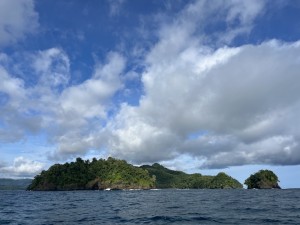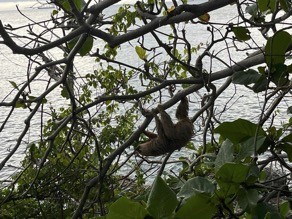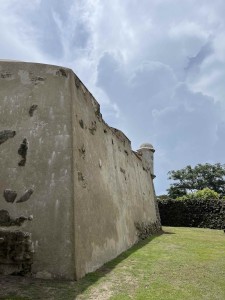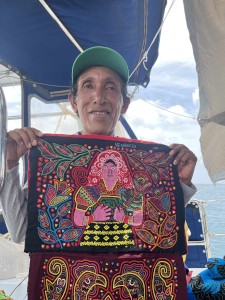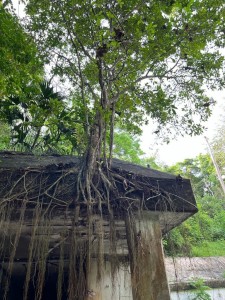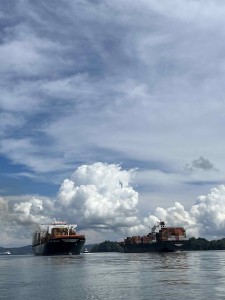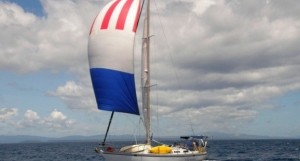Tokimata's Travels
| Vessel Name: | Tokimata |
| Vessel Make/Model: | Ganley S130 steel cutter |
| Hailing Port: | Coromandel, New Zealand |
| Crew: | Peter, Rachel, Danny and Tom Garden |
06 September 2023 | Bahia Nonda
Panama Pacific Coast
It’s now well over a month since we left Panama City. La Brisas the free anchorage on the long causeway joining three islands, was free but not the greatest pace to stay, with poor holding and many disintegrating boats, but this amazing backdrop of skyscrapers behind. These free places where yachts [...]
07 August 2023
Panama City
We fuelled up on 20th July 2023 and filled with water, ready for the passage through the Panama Canal. We were to leave around 2 pm next day, staying overnight in Gatun lake with our local line-handlers, and should be through by 3 pm on the following day.
21 July 2023
Rio Chagres and Portabelo on the Caribbean coast of Panama.
We left the San Blas islands on July 10 2023, after a last visit to Ivin, the wonderful chef at Hollandais Cays. He gave a few more image files for his recipe book and we bought his terrific coconut cake one last time. At 11.30 we upped anchor and were off on our way back east, the transit through the [...]
13 July 2023
The islands of San Blas
On Friday 23rd June at last we headed across the busy canal entrance from Shelter Bay marina and into the Caribbean sea. We were sailing to the San Blas islands, Kuna Yala to the inhabitants, hundreds of small islands and coastal villages that are still administered by the indigenous owners of the land. [...]
30 June 2023
The jungles of Panama
Grinding rust on the hull of Tokimata eventually gave way to grinding rust on the decks, but this was made much easier by hiring energetic boatyard workers. Eventually this progressed to painting, using two part polyurethane over the various anti-rust treatments and primers they had applied. However [...]
07 June 2023
Two weeks in Panama
We arrived in Panama City Tuesday 23rd May from Manchester, with our usual heavy luggage: this time a Starlink system was the bulk of it along with other boat essentials. After travel via Amsterdam we arrived at last to see our taxi-driver holding a “Mr Peter” sign and were off for the hour and a [...]
Greenland's majestic west coast.
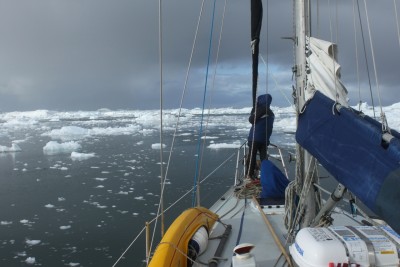
So we decided to see some of the sights, especially since Dan and Tom would not be with us next season, and head south 300 miles to Nuuk. We filled up with the cheapest diesel we had seen all year (around US$1.00 per litre - way cheaper than the US) and after 4 days in Aasiaat headed north east across Disko Bay towards Illulisat (formally known as Jakobshavn) to visit the famous ice fjord. Sermeq Kujalleq glacier is just a couple of miles south of the town in Illulisat Fjord. It is the most active glacier in the northern hemisphere, moving at 19 metres per day and calving some 35 cubic kilometres of ice into the sea annually. It accounts for 10% of all the ice calved off glaciers in Greenland. The ocean current flows north up the west coast of Greenland and this takes all the ice up the coast and then across the top of Baffin Bay and into the Canadian arctic islands. It was icebergs from these glaciers we had seen in Lancaster Sound and Pond Inlet, and even as far away as the east end of Bellot Strait. Some of them move south again down the east coast of Baffin Island and into the north atlantic near Newfoundland where shipping can encounter them, as the Titanic did so famously. Some of them are so large it takes years for them to melt.
The wind had been blowing strongly from the north for a few days before we left Aasiaat, and ice from the fjord had blown south to form an ice field 20 miles east to west and 10 miles north to south, lying way out from the fjord and pushing right onto the shore at the town. This ice is quite different from arctic pack ice which is frozen sea water. Ice calved from glaciers is of course fresh water, and is dominated by huge towering bergs - some hundreds of metres high and up to 1km long. Between these are pieces of ice of all sizes down to small brash. As we pushed through from the south the ice got thicker and thicker until we were only 1 1/2 miles from the harbour of Illulisat, the coloured houses perched on the rock ahead of us quite visible. While we could dodge the bergy bits at first, we then had to slow down to 2 or 3 knots and push the bigger pieces out of the way with our ice poles (also know as "tuks"). We finally came to a halt as the ice completely blocked our way. Tackling ice thicker than anything we had encountered on the northwest passage we powered forward and Tokimata's steel bow lifted 15 cms as it rode up onto the ice then slid back. Powering forward again the ice cracked under the weight of the hull and began to drift apart. On the third attempt we could push the pieces apart and make our way slowly forward. This refrozen brash ice was only about 20 or 30cms thick and only continued for a few hundred metres before we got into clearer water.
As we got clear of the thick ice we met two 10m fishing boats laying out long lines for catching halibut. Apparently the best fishing is just in front of the big icebergs - a risky business as they can topple over unpredictably. As they laid out their lines a crewman was shooting seagulls trying to get at the bait. They are certainly trigger-happy in Greenland and we had already seen seals and musk ox shot by locals being brought into the market in Aasiaat. Polar bears are not often seen on the west coast of Greenland as they will get shot before they get close to a town or settlement.
We made our way into the tiny harbour of Illulisat, completely crammed with boats. There was nowhere obvious to tie up and in the inner harbour not even enough room to turn the boat around without doing a 10 point turn. So we rafted up outside four fishing boats. Our friendly neighbour invited us for coffee and explained we would be OK for 48 hours as more bad weather was coming, no one would leave until after that.
Its about a 30 minute walk through the town and up a hill to a ridge overlooking the ice fjord. The calving face of the glacier is about 15km up the fjord but the viewpoints show water spectacularly full of ice, huge bergs hundreds of metres high foundered on shallow spots at the mouth of the fjord. The site is truely amazing and no wonder it is designated a Unesco World Heritage site. RIght on the edge of the fjord is a small beach where the remains of grass turf and sod houses still exist from settlements dating back more than 2000 years. Clearly this area was always productive in terms of food with ample seals, fish, berries and whales to support local communities.
We left Illulissat late the next afternoon and after a couple of days of strong southerly winds most of the ice had blown clear except for the big bergs. We sailed due west out of Disko Bay in a nice 30 knot southerly on the beam and around the southern tip of Disko Island and into the little port of Qeqertarssuaq (or Godhavn meaning Good Harbour in Danish), where we arrived at around 2am as the wind died. This town of less than 1000 people perched on rocky slopes around a perfect enclosed harbour. High peaks rise to the north of the town and the snow cap that covers the central part of Disko Island was visible. Dan and Tom set off to climb the peaks and ended up on the glacier at the edge of the snow cap where they found a shipping container full of husky dog food that must be a cache for winter sledging. An icy descent in the dark on improvised crampons didn't see them calling us for a pickup in the dinghy until after midnight!
Next day we headed south, passing Aasiaat and heading down the coast towards some of the big fjords cutting up to 100km inland. After a scenic stop en-route we entered Evigheds Fjord and anchored in a bay that had been a base for the sailor/mountaineer H.W. Tillman in the 1960's. We hid out here for 3 days while another of the now frequent storms blew through until a clear day arrived and we could explore up the fjord, visiting one of the three or four spectacular tide-water glaciers that empties into it.
The final 200 mile stretch of coast to Nuuk we sailed over two days and nights - sometimes ducking into inside passages and other times outside the myriad of small coastal islands. At Nuuk we met up with the Danish sailboat "Sol" again, and started our final preparations for leaving Tokimata over the winter.
There is no cost at all for leaving a boat in the water in one of the public harbours in Greenland. The harbourmaster directed us to a good looking spot beside a large wooden ex-fishing vessel. With 4 metre tides in Nuuk it is easier to tie up to another large vessel that is going up and down against the rough commercial docks so your own lines can be tight, holding you close to the larger boat. Nuuk harbour does get ice in winter - up to 30cms thick sea ice, and bergy bits from glaciers - but freighters and large fishing boats keep operating all year round and stir up the ice as they move about, pushing chunks into the sides of moored boats. The locals told us to expect some ice scuffs and scratches on the hull. A couple of locals, and an Austrian couple in a sailboat planning to do the NW Passage east to west next year, have offered to keep an eye on the boat for us. Everything has been taken off deck to reduce windage - sails, bimini, clears, liferaft all put away below, along with the dinghy and kayak. It does blow in Nuuk - we had one blow of 50 knots across the deck in the harbour in the week we were there and all boats tie up facing south into the prevailing wind.
We will be back in May and plan to cruise down the south west coast of Greenland and then to Iceland and over to Scotland and Wales.
